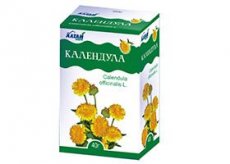Medical expert of the article
New publications
Preparations
Calendula flowers
Last reviewed: 03.07.2025

All iLive content is medically reviewed or fact checked to ensure as much factual accuracy as possible.
We have strict sourcing guidelines and only link to reputable media sites, academic research institutions and, whenever possible, medically peer reviewed studies. Note that the numbers in parentheses ([1], [2], etc.) are clickable links to these studies.
If you feel that any of our content is inaccurate, out-of-date, or otherwise questionable, please select it and press Ctrl + Enter.

Indications marigold flowers
The use of calendula flower baskets is possible for the treatment of the following diseases:
- dental pathologies (childhood oral candidiasis, gingivitis, pyorrhea, dystrophic periodontosis);
- sore throat, tonsillitis;
- gynecological pathologies (cervical erosion, trichomonas colpitis);
- proctitis, paraproctitis;
- minor wounds, bruises, scratches, boils, burn surfaces;
- blepharitis;
- cardiovascular pathologies (tachycardia, coronary heart disease, hypertension);
- gastritis, gastric ulcer and duodenal ulcer, enterocolitis, colitis, liver and biliary tract diseases;
- insect bites.
 [ 3 ]
[ 3 ]
Release form
Calendula flowers are produced in the form of dried and crushed raw materials, placed in cardboard packaging. One package contains 50 g of dry plant.
The plant material consists of flower baskets, up to 50 mm in diameter, as well as shoot elements up to 30 mm long.
The color of the flower baskets is greenish-gray, the outer flowers can have a reddish-brown and yellowish tint. The aroma is insignificant, medicinal. The taste is bitter-salty.
Active ingredient: Flores Calenduae.
 [ 4 ]
[ 4 ]
Pharmacodynamics
Calendula and the flowers of this plant have a complex composition. It contains:
- carotenoids – natural organic pigments (in the form of carotene, cirtaxanthin, flavochrome, lycopene, rubixanthin, violaxanthin);
- flavonoids – plant polyphenols (in the form of isoquercitrin, rhamnetin, narcissin);
- essential oils;
- saponins are heterosides of plant origin;
- bitters (calendin, arnidiol, faradiol);
- resins and binders;
- mucous components;
- organic polysaccharide inulin;
- acidic components (in the form of malic, pentadecyl, salicylic acids);
- plant sterol;
- ascorbic acid;
- enzymes;
- alkaloid substances.
The listed combination of bioactive ingredients determines the anti-inflammatory, regenerative, bacteriostatic, analgesic and choleretic properties of the plant. Extracts and infusions from calendula raw materials when taken orally create favorable conditions for the restoration of the integumentary tissues of the digestive tract, which promotes the healing of ulcerative and erosive surfaces. Calendula flowers are also known to reduce high blood pressure and stabilize coronary function.
 [ 5 ]
[ 5 ]
Dosing and administration
Calendula flowers can be used in the following main ways:
- in the form of a tincture. Alcohol tincture is a mixture of 70% alcohol and calendula baskets in a ratio of 1:10. For medicinal purposes, take 1 teaspoon of tincture diluted in 200 ml of liquid. As a choleretic agent, it is recommended to take 15 drops of the medicine at a time;
- in the form of a herbal infusion. To prepare the infusion, take 10 g (1 tbsp.) of dried flowers per 100 ml of hot water, keep in a water bath for about a quarter of an hour, then cool to room temperature, filter and store in the refrigerator. The remedy can be taken 1-2 tbsp. up to 3 times a day.
In addition, calendula flower infusion is used for gargling for sore throats and gum diseases, up to 4 times a day until complete recovery.
Use marigold flowers during pregnancy
External use of preparations from calendula flowers is allowed during pregnancy and breastfeeding. Oral administration in the form of infusions, decoctions, tinctures, etc. is not recommended, since studies on the effect of this herbal remedy on the course of pregnancy and the condition of the child have not been conducted.
If the use of calendula flowers during pregnancy is unavoidable, it is imperative to consult a doctor.
Contraindications
Calendula flowers should not be prescribed:
- during pregnancy and breastfeeding;
- if you are prone to allergies to herbal remedies and biologically active components;
- in childhood (up to 12 years).
In other cases, the use of calendula preparations is permitted unless there are individual warnings from the attending physician.
 [ 8 ]
[ 8 ]
Side effects marigold flowers
Side effects when using calendula flower preparations are rare. However, the following reactions can sometimes be observed:
- allergies (allergic dermatitis, urticaria, Quincke's edema, conjunctivitis);
- when taken orally - bitterness in the mouth, heartburn, epigastric pain.
If any side effects occur, you should stop taking the herbal remedy based on calendula flowers.
 [ 9 ]
[ 9 ]
Overdose
There have been no reported cases of overdose associated with taking calendula flower-based preparations.
 [ 12 ]
[ 12 ]
Interactions with other drugs
The medicinal properties of calendula flowers are more pronounced when used together with chamomile preparations. This increases the antimicrobial, antispasmodic and anti-inflammatory properties of plants. The function of stimulating bile secretion is also enhanced, which helps eliminate bile stasis.
Storage conditions
Calendula plant material is stored in a dark place, at a temperature of +15°C to +25°C, in a closed cardboard package.
The finished infusion is stored in the refrigerator for up to 2 days.
The tincture can be stored at room temperature in a dark place.
Children should not be allowed near places where medicines are stored.
 [ 15 ]
[ 15 ]
Shelf life
Attention!
To simplify the perception of information, this instruction for use of the drug "Calendula flowers" translated and presented in a special form on the basis of the official instructions for medical use of the drug. Before use read the annotation that came directly to medicines.
Description provided for informational purposes and is not a guide to self-healing. The need for this drug, the purpose of the treatment regimen, methods and dose of the drug is determined solely by the attending physician. Self-medication is dangerous for your health.

